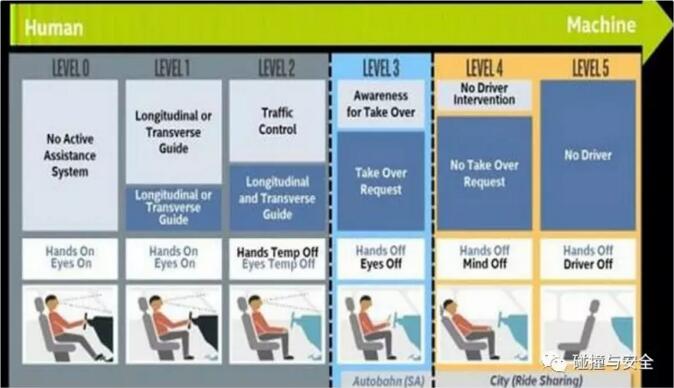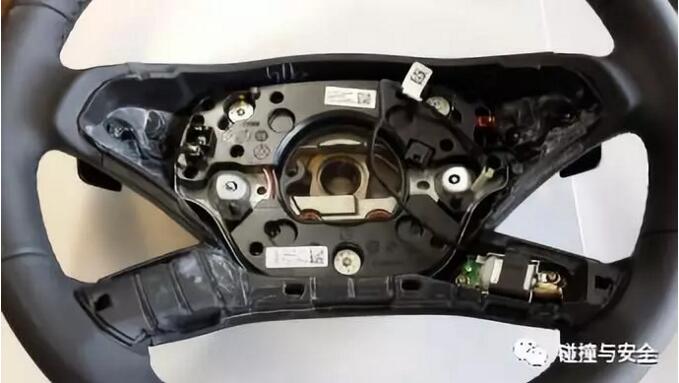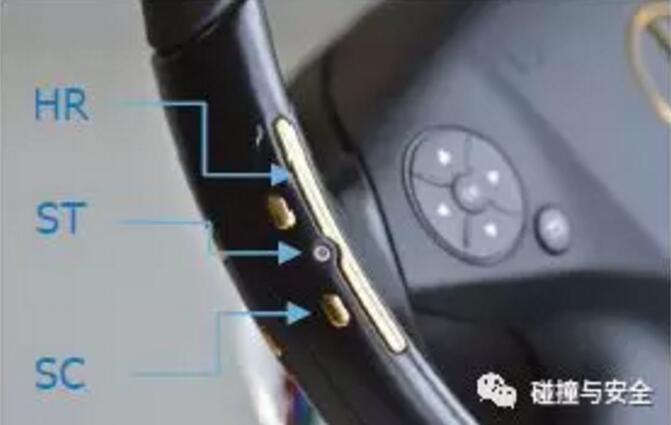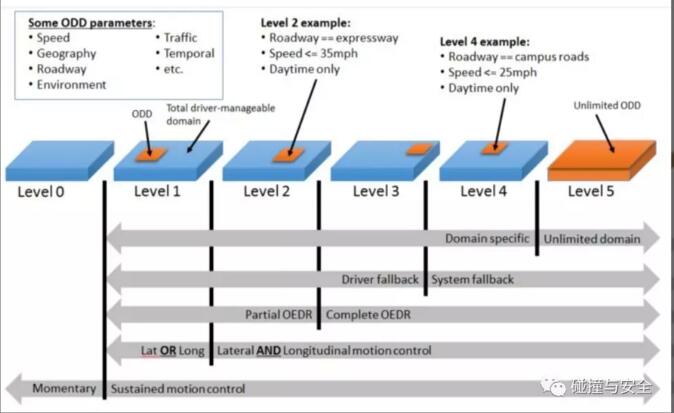Autonomous driving is the direction of future automobile development that is widely recognized by everyone and has been enthusiastically pursued by various companies of all sizes. At present, the mainstream autonomous driving level classification adopts the regulations of SAE. The latest definition of SAE J3016 divides autonomous driving into Level 0-Level 5, a total of 6 stages. Among them, Level 0-2 is mainly the stage where the driver is in charge, and from Level 3 onwards, partial autonomous driving functions are gradually realized.
Here is a picture that can simply distinguish the differences between these levels for drivers:

As can be seen from the above figure, starting from level 2, the driver's eyes and hands do not need to pay attention to the driving road conditions and steering wheel all the time. Although it seems easy, the driving road conditions and driving operations become very complicated because of the various road conditions (ODD) and operation matching issues. As the unit that directly contacts the driver, the steering wheel needs to bear the responsibility of detecting/reminding the driver.
From this perspective, the ideas/concepts of steering wheels proposed by the industry are as follows:
Vibrating steering wheel
The vibration control unit in the steering wheel sends a command to start the motor in the vibration mechanism, which drives the eccentric block to rotate, so that the steering wheel rim vibrates, thereby achieving the purpose of reminding the driver. This is a reminder function that can cooperate with the design intention/sensor connection to warn of danger (lane deviation, oncoming collision warning, blind spot detection reminder, or when the driver is tired).

HOD hand-off detection touch reminder
The film-like sensor is wrapped under the leather and above the PU, continuously monitoring the driver's hand grip pressure state and feeding it back to the ECU for analysis. The ECU analyzes whether it is abnormal based on driving habits, and reminds the driver through warning lights, warning sounds or vibrations. This function may seem useless, but when combined with vibration detection, it can remind the driver to concentrate on driving. When you want to doze off, it will vibrate you without hesitation! If combined with automatic driving, it can be used as a switch between automatic driving and manual driving. Therefore, this function is a must-have function for level 3.

Light sensor steering wheel
The steering wheel rim is integrated with an optical component with sensors. Through infrared sensing technology, it can realize many operations such as phone on/off, volume adjustment, adaptive cruise control, and automatic driving. The product sounds cool, after all, it can have lighting effects, and in theory, it can also realize the function of hand-off detection.
But to be honest, if there are so many different sensors integrated on the rim, as a hyperactive person, I am very worried that I will have no place to put my hands, or that unnecessary functions will be triggered by mistake. I still look forward to the rationalization of the layout and design in the future.
Then, after the steering wheel inspection is completed, our drivers will have some free time. During this short free time, we can consider improving the convenience and comfort of driving. From this perspective, we can have the following development directions:
Health Check
As the ancients said, the economic foundation realizes the upper construction, and the ancients also said, keep warm and think about that, which means that we mortals will not be satisfied with the status quo, and there will always be higher pursuits. Thinking about the excellent tradition of Zhen Huan and Hua Fei checking the pulse three times a day, we still need to have a health detection function on the steering wheel. The principle is to arrange various sensors in the steering wheel to detect heart rate, skin temperature, resistance, and determine the driver's fatigue and stress status after data processing.

Fingerprint recognition
Bind user settings to fingerprints to automatically configure user settings (media information, seat mirrors, steering wheels, etc.)

Think about it carefully, what is the ultimate goal of our autonomous driving! It is to do nothing! When we have fully realized autonomous driving, why do we still need a steering wheel? What! Throw it away!
However, we also have to consider some driving enthusiasts' ideas, we can also do this:
Foldable steering wheel (level 4+)
Simply put, it is a folding bed, just like a folding bicycle. You can take it out when you want to use it, and put it away when you don't want to use it. This sounds a bit low-level. Cars can drive automatically, but the steering wheel still needs to be folded manually? It's unreasonable. Let's take a look at this concept: the steering wheel can be retracted with a button. But now you can only look at the concept map to satisfy your curiosity, after all, it's just a concept.

remote control
When the car can drive completely automatically, theoretically I can realize all functions with just a few buttons, then can we play the real-life version of Need for Speed game?
Finally, here are the differences in the classification of autonomous driving:

Previous article:Schaeffler announces: OmniSteer research project is successful, lateral parking will become a reality
Next article:PCB-less Hall latch solution for automotive seat motor positioning
- Popular Resources
- Popular amplifiers
- Car key in the left hand, liveness detection radar in the right hand, UWB is imperative for cars!
- After a decade of rapid development, domestic CIS has entered the market
- Aegis Dagger Battery + Thor EM-i Super Hybrid, Geely New Energy has thrown out two "king bombs"
- A brief discussion on functional safety - fault, error, and failure
- In the smart car 2.0 cycle, these core industry chains are facing major opportunities!
- The United States and Japan are developing new batteries. CATL faces challenges? How should China's new energy battery industry respond?
- Murata launches high-precision 6-axis inertial sensor for automobiles
- Ford patents pre-charge alarm to help save costs and respond to emergencies
- New real-time microcontroller system from Texas Instruments enables smarter processing in automotive and industrial applications
- Innolux's intelligent steer-by-wire solution makes cars smarter and safer
- 8051 MCU - Parity Check
- How to efficiently balance the sensitivity of tactile sensing interfaces
- What should I do if the servo motor shakes? What causes the servo motor to shake quickly?
- 【Brushless Motor】Analysis of three-phase BLDC motor and sharing of two popular development boards
- Midea Industrial Technology's subsidiaries Clou Electronics and Hekang New Energy jointly appeared at the Munich Battery Energy Storage Exhibition and Solar Energy Exhibition
- Guoxin Sichen | Application of ferroelectric memory PB85RS2MC in power battery management, with a capacity of 2M
- Analysis of common faults of frequency converter
- In a head-on competition with Qualcomm, what kind of cockpit products has Intel come up with?
- Dalian Rongke's all-vanadium liquid flow battery energy storage equipment industrialization project has entered the sprint stage before production
- Allegro MicroSystems Introduces Advanced Magnetic and Inductive Position Sensing Solutions at Electronica 2024
- Car key in the left hand, liveness detection radar in the right hand, UWB is imperative for cars!
- After a decade of rapid development, domestic CIS has entered the market
- Aegis Dagger Battery + Thor EM-i Super Hybrid, Geely New Energy has thrown out two "king bombs"
- A brief discussion on functional safety - fault, error, and failure
- In the smart car 2.0 cycle, these core industry chains are facing major opportunities!
- The United States and Japan are developing new batteries. CATL faces challenges? How should China's new energy battery industry respond?
- Murata launches high-precision 6-axis inertial sensor for automobiles
- Ford patents pre-charge alarm to help save costs and respond to emergencies
- New real-time microcontroller system from Texas Instruments enables smarter processing in automotive and industrial applications
- Surface Wave Filters in RF Circuits
- Inductor selection issues
- The story of motor drive integration
- Generation and Operation of Discrete Signals in DSP
- Selection of pull-up resistor value for common communication line
- Constant current source + NMOS and PMOS (MCU control on and off) + LED solution consultation
- The role of MDB-RS232 adapter in vending machines
- 2.4G Wireless Microphone in the Wireless Era
- Are there still people using USB shields now? What is the principle?
- Studying the Road to Electric Motor Drive-4: Vector and Scalar

 TC52N2735ECTRT
TC52N2735ECTRT











 京公网安备 11010802033920号
京公网安备 11010802033920号